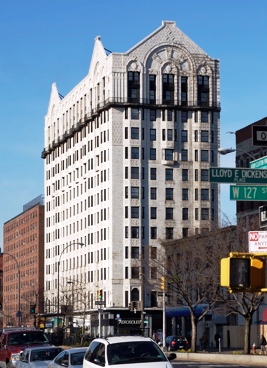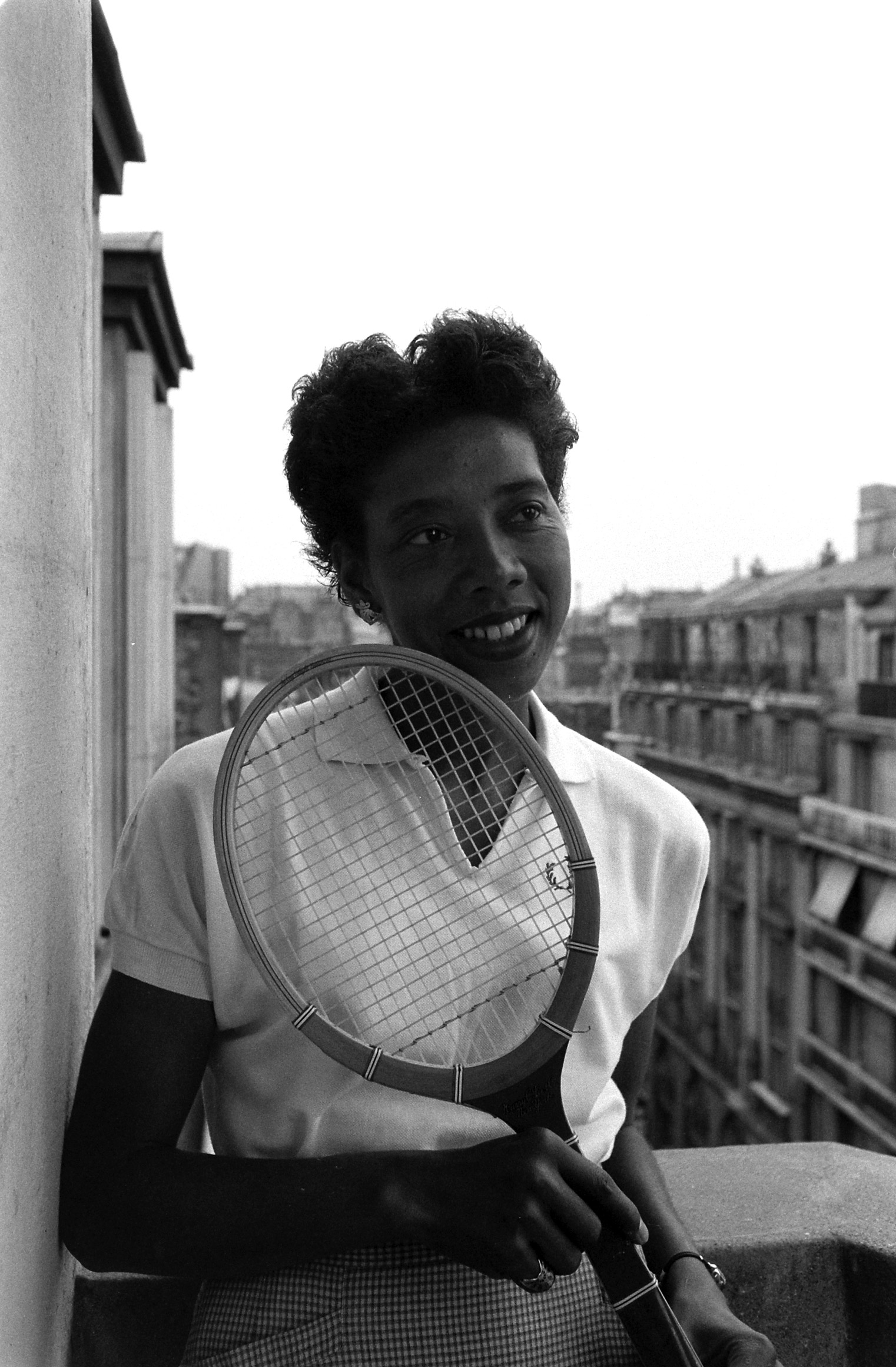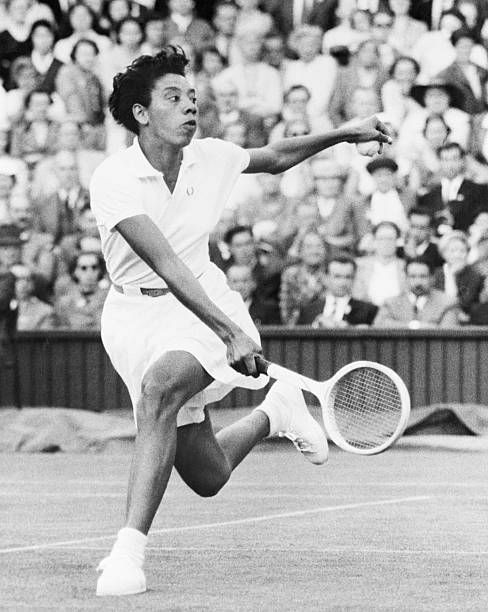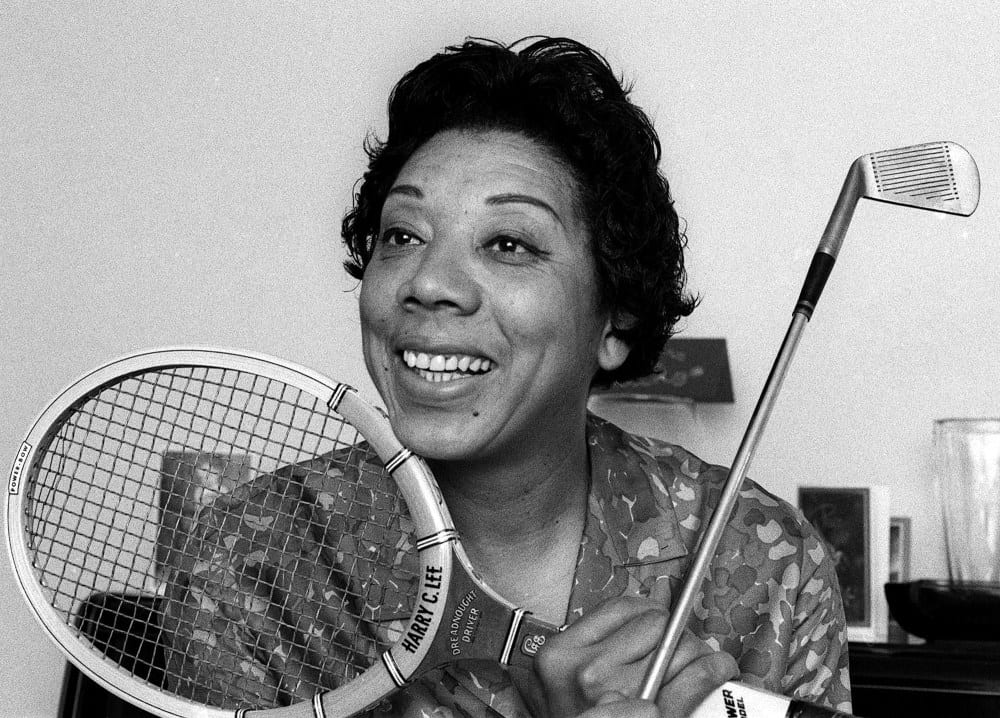"Now matter what accomplishment you make, somebody helped you."
-Althea Gibson
Althea Gibson: The Legend of Tennis
The journey of the African American athlete has been a journey filled with adversity and triumph. Tons of us know about Allyson Felix, Jackie Joyner-Kersee, Michael Jordan, and Lebron James. Other human beings don't know about the sacrifice of early African American athletes who risked their lives so we could live now like: William Edward White, Major Taylor, Isaac Murphy, Lucy Diggs Slowe, Alice Coachman Davis, and Bill Powell. For decades, Althea Gibson has been the icon of athletics. Involving tennis, Althea Gibson existed as a trailblazer who loved the art of sports. Not to mention that future black tennis legends like Arthur Ashe, Serena Williams, Venus Williams, James Blake, and Zina Garrison have outlined their own greatness in numerous, diverse ways. That is why I desired to create this work of prose. For over 2 decades now, I have been on this august journey to research the mysteries of life. This quest hasn't stop in the decade of the 2020's. Many know about Gibson, but some don't know about her great character and heroism. Althea Gibson (1927-2003) was a daughter of courageous parents, and she was born in the South. Additionally, Gibson was raised in the North at Harlem, New York City.
As a natural born athlete, she never gave up on her dreams and aspirations. Her family, her coaches, and her tennis peers supported her along her life's journey. A powerful serve existed in her game. Althea Gibson made extraordinary accomplishments during the duration of her life from winning tournaments to playing golf. Althea Gibson's life was not easy. Discrimination, financial struggles, and a lack of respect for her existed in her life. That is why we must treat people rightly with dignity and with respect while we live in the world. Althea Gibson definitely deserved so much more honor back then and today. Breaking down barriers and being humble at the same time are always part of her personal ethos. Yet, real people will always praise her tenderness, her strength, and her love for the beauty plus the glory of athletics. Althea Gibson was always appreciated by her peers. Muhammad Ali communicated with her in a celebration. She praised the legendary boxer Sugar Ray Robinson by kissing him in his cheek. She also created her own music in a further extension of her own soul. In the stories of black history, I made sure that human beings cherish the story of Althea Gibson. That's why I created this work. The public has the right to witness the truth about this heroic black woman.


Her Early Life
To know about Althea Gibson is to know about her story. In the beginning, Althea Gibson was born in the South at Silver, South Carolina on August 25, 1927. Her parents were Daniel and Annie Bell Gibson. Both of them worked as sharecroppers on a cotton farm. By 1930, Gibson and her family moved north to Philadelphia and then in Harlem, New York City via the Great Migration. The First and Second Great Migrations among African Americans were some of the most important events of American history. Black people wanted to escape the murderous Jim Crow apartheid capitalist system of the South. The irony is that many of the same oppression (i.e. police brutality, economic oppression, racism, discrimination, etc.) existed in the North, the Midwest, and the West Coast too. Harlem was massively different than South Carolina. Althea Gibson had 3 sisters and a brother. Harlem had black people who came from the South, black people from the Caribbean, and black people who lived in New York City for centuries. It is a very urbanized environment. She lived in an apartment on a stretch of 143rd Street, between Lenox Avenue and Seventh Avenue. The area had a play area where kids could play during the day time.
Althea Gibson never backed down from adversity. She competed in sports with the boys, and she won many sporting events. At the age of 12 in 1939, she became the New York City's women's paddle tennis champion. Althea Gibson was taught boxing skills by her father. So, she watched movies, did street fighting, and played girls basketball. By 1940, she changed direction by joining the Cosmopolitan Tennis Club in the Sugar Hill section of Harlem. She didn't like tennis at first, but she loved it later on. By 1941, Althea entered and won her first tournament, the American Tennis Association (ATA) New York State Championship. By 1944, Althea moved into Wilmington, North Carolina. She lived with Dr. Hubert Eaton and her family. She attended Williston Industrial High School during the winter and spent summers in Lynchburg, Virginia with Dr. Robert W. Johnson (who was a Lynchburg, Virginia physician, and he was active in the African American tennis community. Dr. Johnson would later mentor Arthur Ashe too) and his family. Dr. Johnson had a huge influence in her life to inspire her to be more competitive and achieve her own dreams involving athletics. She worked on her tennis game by traveling to ATA tournaments. She graduated from high school in 1946 from the racially segregated Williston Industrial High School. She continued to make history. She won the ATA national championship in the girls' division in 1944 and 1945, and after losing in the women's final in 1946, won her first of ten straight national ATA women's titles in 1947. In 1949, Althea becomes the first black woman, and the second black athlete (after Reginald Weir), to play in the USTA’s National Indoor Championships. She lost narrowly in the second round in a rain-delayed, three-set match to Louise Brough, the reigning Wimbledon champion and former U.S. National winner. During the same year, she entered Florida A&M University on a full athletic scholarship. She was a member of the Beta Alpha chapter of Alpha Kappa Alpha sorority. "I knew that I was an unusual, talented girl, through the grace of God," she wrote. "I didn't need to prove that to myself. I only wanted to prove it to my opponents." Dr. Johnson gave Althea Gibson extensive training.


Great Accomplishments and Inspiration
Because of racism, Gibson was once barred from entering the premier American tournament of the United States National Championships (now the U.S. Open) at Forest Hills. While USTA rules officially prohibited racial or ethnic discrimination, players qualified for the Nationals by accumulating points at sanctioned tournaments, most of which were held at white-only clubs. In 1950, in response to intense lobbying by ATA officials and retired champion Alice Marble—who published a scathing open letter in the magazine American Lawn Tennis—Gibson became the first Black player to receive an invitation to the Nationals, where she made her Forest Hills debut a few days after her 23rd birthday. By 1950, she was the first African American to play the U.S. Nationals, at Forest Hills in Queens, NYC. She lost to Louise Brough in the 2nd round. In 1951, Gibson won her first international title, the Caribbean Championships in Jamaica, and later that year became one of the first Black competitors at Wimbledon, where she was defeated in the third round by Beverly Baker. In 1952 she was ranked seventh nationally by the USTA.
By 1953, Althea Gibson graduated from Florida A&M University. She soon took a job teaching physical education at Lincoln University in Jefferson City, Missouri. During her two years at Lincoln, she became romantically involved with an Army officer whom she never named publicly. Gibson considered enlisting in the Women's Army Corps, but she decided against it when the State Department sent her on a goodwill tour of Asia in 1955 to play exhibition matches with Ham Richardson, Bob Perry, and Karol Fageros. Many Asians in the countries they visited—Burma, Ceylon, India, Pakistan, and Thailand—"felt an affinity to Althea as a woman of color and were delighted to see her as part of an official US delegation. With the United States grappling over the question of race, they turned to Althea for answers, or at least to get a firsthand perspective." Althea Gibson strengthened her confidence during the six week tour. When it was over, she remained abroad, winning 16 of 18 tournaments in Europe and Asia against many of the world's best players.
Her life changed forever in 1956. In that year, Althea Gibson won the French Open singles and doubles at the French Open and Wimbledon (both with Angela Buxton). She was the first African American to win a Grand Slam tournament and the French Championships single even. In 1957, Althea Gibson won Wimbledon and U.S. Nationals. She is the first African American to win either tournament. Upon her return home, Gibson became only the second black American, after Jesse Owens, to be honored with a ticker tape parade in New York City. Later in the season she won the Wimbledon doubles championship (again with Buxton), the Italian Championships in Rome, the Indian Championships in New Delhi, and the Asian championship in Ceylon. She also reached the quarter-finals in singles at Wimbledon and the finals at the US Nationals, losing both to Shirley Fry. The 1957 season was Althea Gibson's great year. In July 1957, she was seeded first at Wimbledon. She defeated Darlene Hard in the finals of the singles titles. She was the first Black champion in the tournament's 80-year history, and the first champion to receive the trophy personally from Queen Elizabeth II.


"Shaking hands with the Queen of England [sic]", she said, "was a long way from being forced to sit in the colored section of the bus." She won the doubles championship as well, for the second year. Upon her return home Gibson became only the second Black American, after Jesse Owens, to be honored with a ticker tape parade in New York City, and Mayor Robert F. Wagner Jr. presented her with the Bronze Medallion, the city's highest civilian award. A month later she defeated Brough in straight sets to win her first US National Championship. "Winning Wimbledon was wonderful", she wrote, "and it meant a lot to me. But there is nothing quite like winning the championship of your own country." In all she reached the finals of eight Grand Slam events in 1957, winning the Wimbledon and US National singles titles, the Wimbledon and Australian doubles championships, and the US mixed doubles crown, and finishing second in Australian singles, US doubles, and Wimbledon mixed doubles. At season's end she broke yet another barrier as the first Black player on the US Wightman Cup team, which defeated Great Britain 6–1. When she played, Gibson was subjected to racist slurs from people in the audience including some were trying to spit on her.
In 1958, Althea repeated her single title wins at both Wimbledon and U.S. Nationals, and retired from tennis. She was the number-one-ranked woman in the world and in the United States in both 1957 and 1958, and was named Female Athlete of the Year by the Associated Press in both years, garnering over 80% of the votes in 1958. She also became the first black woman to appear on the covers of Sports Illustrated and Time magazines. Later, she was signed to play a series of exhibition matches against Koral Fageros before Harlem Globetrotter basketball games in 1959. Her music record album Althea Gibson Sings was released in the same year. She performed 2 of its songs on The Ed Sullivan Show. She also appears as a celebrity guest on the TV panel show What’s My Line? and was cast as a slave woman in the John Ford film The Horse Soldiers (1959).
In late 1958, having won 56 national and international singles and doubles titles, Gibson retired from amateur tennis. Prior to the Open Era there was no prize money at major tournaments, and direct endorsement deals were prohibited. Players were limited to meager expense allowances, strictly regulated by the USTA. "The truth, to put it bluntly, is that my finances were in heartbreaking shape", she wrote. "Being the Queen of Tennis is all well and good, but you can't eat a crown. Nor can you send the Internal Revenue Service a throne clipped to their tax forms. The landlord and grocer and tax collector are funny that way: they like cold cash ... I reign over an empty bank account, and I'm not going to fill it by playing amateur tennis." Professional tours for women were still 15 years away, so her opportunities were largely limited to promotional events. In 1959 she signed to play a series of exhibition matches against Fageros before Harlem Globetrotter basketball games. When the tour ended she won the singles and doubles titles at the Pepsi Cola World Pro Tennis Championships in Cleveland, but received only $500 in prize money. Althea Gibson was a musician. She can sing and play the saxophone. She fought racial discrimination constantly: "When I looked around me, I saw that white tennis players, some of whom I had thrashed on the court, were picking up offers and invitations", she wrote. "Suddenly it dawned on me that my triumphs had not destroyed the racial barriers once and for all, as I had—perhaps naively—hoped. Or if I did destroy them, they had been erected behind me again."


Her Later Life
By 1960, she wrote her own memoir with Ed Fitzgerald, and it was published. The book is entitled, "I Always Wanted to Be Somebody." By 1964, at the age of 37 years old, Althea Gibson became the first African American woman to join the Ladies Professional Golf Association (LPGA) out. Racial discrimination continued to be a problem: Many hotels still excluded people of color, and country club officials throughout the south—and some in the north—routinely refused to allow her to compete. When she did compete, she was often forced to dress for tournaments in her car because she was banned from the clubhouse. Although she was one of the LPGA's top 50 money winners for five years, and won a car at a Dinah Shore tournament, her lifetime golf earnings never exceeded $25,000. She made financial ends meet with various sponsorship deals and the support of her husband, William Darben, brother of best friend and fellow tennis player Rosemary Darben, whom she married in 1965.
She married William Darben until 1976 when they divorced. By 1976, she was appointed New Jersey’s athletic commissioner, the first woman in the country to hold such a role.
While she broke course records during individual rounds in several tournaments, Gibson's highest ranking was 27th in 1966, and her best tournament finish was a tie for second after a three-way playoff at the 1970 Len Immke Buick Open. She retired from professional golf at the end of the 1978 season. "Althea might have been a real player of consequence had she started when she was young", said Judy Rankin. "She came along during a difficult time in golf, gained the support of a lot of people, and quietly made a difference." In 1972, she began running Pepsi Cola's national mobile tennis project, which brought portable nets and other equipment to underprivileged areas in major cities. She ran multiple other clinics and tennis outreach programs over the next three decades, and coached numerous rising competitors, including Leslie Allen and Zina Garrison. "She pushed me as if I were a pro, not a junior", wrote Garrison in her 2001 memoir. "I owe the opportunity I received to her."
In 1976, Althea Gibson made it to the finals of the ABC TV program called Superstars. She finished first in the basketball shooting and bowling. She was runner up in softball throwing. In 1977, Gibson challenged incumbent Essex County State Senator Frank J. Dodds in the Democratic primary for his seat. She came in second behind Dodds but ahead of Assemblyman Eldridge Hawkins. She also managed the Department of Recreation in East Orange, New Jersey. She also served on the State Athletic Control Board and became supervisor of the Governor's Council on Physical Fitness and Sports. The Open Era began, and in her 40's, she struggled to compete against the younger players. She also attempted a golf comeback, in 1987 at age 60, with the goal of becoming the oldest active tour player, but was unable to regain her tour card. In a second memoir, So Much to Live For, she articulated her disappointments, including unfulfilled aspirations, the paucity of endorsements and other professional opportunities, and the many obstacles of all sorts that were thrown in her path over the years.
Althea Gibson married Sydney Llewellyn in 1983. They divorced after 5 years of marriage. By the late 1980's, Althea Gibson suffered 2 cerebral hemorrhages and in 1992, a stroke. Medical expenses depleted her financial resources. She struggled to afford her rent or medication. Though she reached out to multiple tennis organizations requesting help, none responded. Former doubles partner Angela Buxton made Gibson's plight known to the tennis community, and raised nearly $1 million in donations from around the world. Gibson had a heart attack in early 2003. She passed away on September 28, 2003 from respiratory and bladder infections. She was buried in the Rosedale Cemetery in Orange, New Jersey near her first husband, Will Darben. By 2013, the U.S. Postal Service honored Althea Gibson with a commemorative stamp on August 23, unveiled on the U.S. Open grounds in Flushing, NY. She is the first female athlete in the Black Heritage Stamp Series.
"I am honored to have followed in such great footsteps. Her accomplishments set the stage for my success, and through players like myself and Serena and many others to come, her legacy will live on."
-Venus Williams in 2003
Althea Gibson's Glorious Legacy
We're grown here. Althea Gibson's contributions to humanity are very much extensive like setting up youth programs and defending civil rights. When you see the high amount of black tennis players today competing strong, Althea Gibson and other legendary players of the past helped to make that reality possible. The musician Buddy Walker invited her to play tennis on the local courts. In fact, Walker gave Althea Gibson her first tennis racket. To see black culture and real black excellence to flourish in the future, you have to honor the great list of the Brothers and the Sisters who came before us. Arthur Ashe, Venus Williams, Serena Williams (who won 23 singles championships, was 319 weeks at WTA's Number 1 player, won many Olympics Gold Medals, and with other records making Serena Williams the greatest woman tennis player of all time), Cori Gauff, Mal Vai Washington, Lori McNeil, Chanda Rubin, Leslie Allen, Andrea Whitmore, Sloane Stephens, and other tennis player came into the door via the sacrifice of Sister Althea Gibson, Sister Ora Washington, Sister Louise Stokes, Sister Tidye Pickett, Brother Jimmie McDaniels, Brother Jesse Owens, Brother Paul Robeson (he played football), and other outstanding players. In a 1977 historical analysis of women in sports, The New York Times columnist William C. Rhoden wrote the following words:
"Althea Gibson and Wilma Rudolph are, without question, the most significant athletic forces among Black women in sports history. While Rudolph's accomplishments brought more visibility to women as athletes...Althea's accomplishments were more revolutionary because of the psychosocial impact on Black America. Even to those Blacks who hadn't the slightest idea of where or what Wimbledon was, her victory, like Jackie Robinson's in baseball and Jack Johnson's in boxing, proved again that Blacks, when given an opportunity, could compete at any level in American society." (Rhoden, WT: "A Fruitful Past But a Shaky Future." Ebony, Vol. 32, No. 10, August 1977, pp. 60-64).
By the year of 1980, Althea Gibson was inducted into the International Women's Sports Hall of Fame. She received the Candace Award from the National Coalition of 100 Black Women in 1988. She was inducted into the Black Athletes Hall of Fame, and other Halls of Fame too. In 1991, Althea Gibson became the first woman to receive the Theodore Roosevelt Award, which is the highest honor from the National Collegiate Athletic Associated. She was cited for "symbolizing the best qualities of competitive excellence and good sportsmanship, and for her significant contributions to expanding opportunities for women and minorities though sports." To this day, the Althea Gibson Foundation has helped gifted golf and tennis players who live in urban communities. Statues honor her (like the bronze statue of Althea Gibson. It was created by sculptor Thomas Jay Warren, and the statue is found in Branch Brook Park at Newark, New Jersey since 2012), and Gibson was featured in the 2015 PBS documentary called Althea. I have watched the entire documentary before. Althea Gibson was an once in a lifetime athlete had a grace, a spirit of determination, and a love to present music. She touched so many souls with her bright presence. Today, we have Title IX and other legitimate laws help women, black people, and other people of color. Yet, we still have a long way to go in making sure that justice for all is made a reality. Even in 2021, we are still fighting for our voting rights to be protected which is a shame. Likewise, we won't give up on our quest for liberty. We still want our rights now. The icon Althea Gibson didn't live long enough to see how many folks truly loved her, but we love her whole being as a total representation of Black Excellence personified.

Rest in Power Sister Althea Gibson
'Ase.
By Timothy















